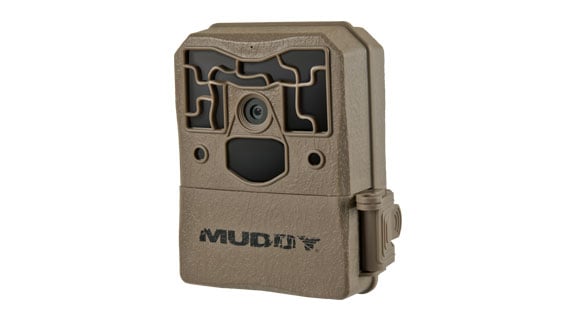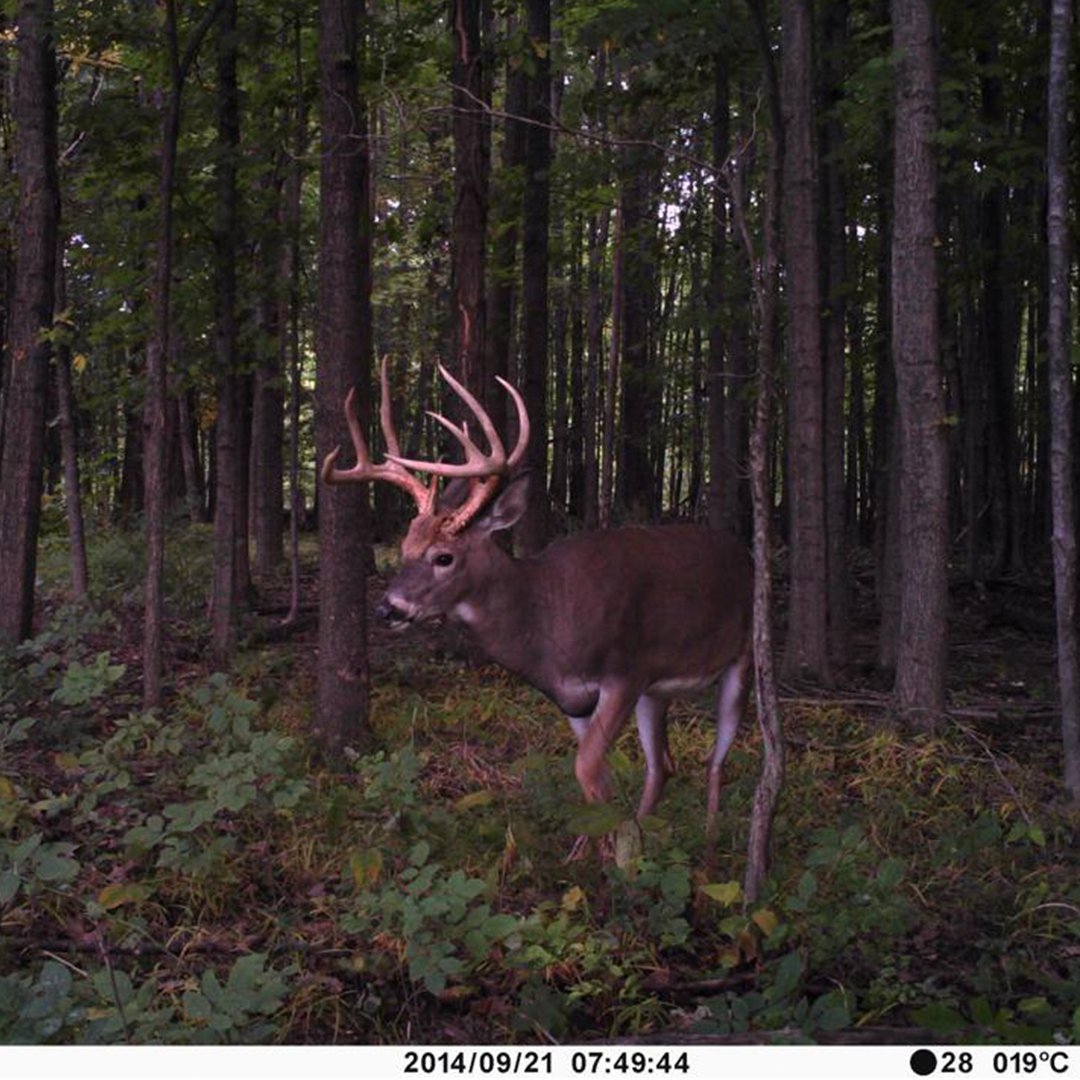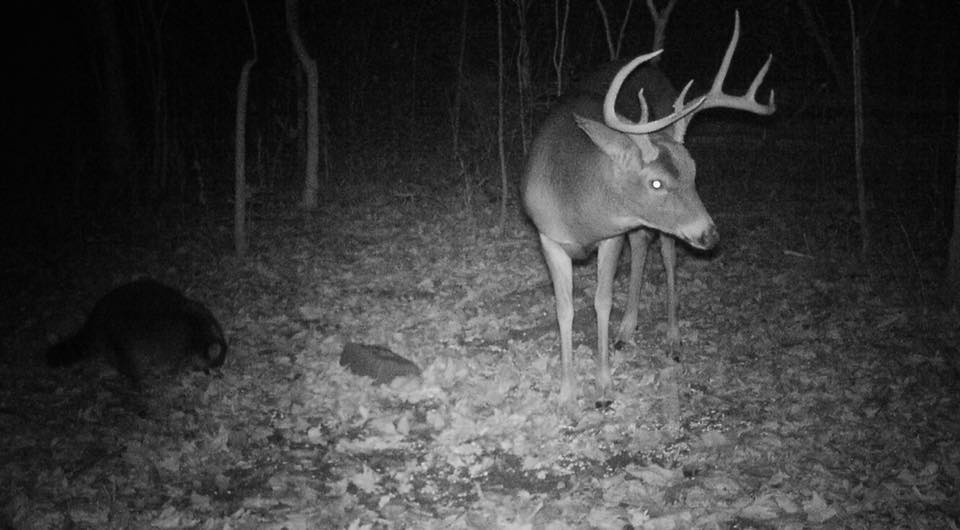Using Trail Cameras to Locate a Buck's Core Area
/ September 13th, 2017Trail cameras featuring todays technologies can be pretty impressive. Sending images in real time via cellular service directly to your phone to alert you when a deer steps in front and triggers the camera is a remarkable advancement, and a testament to the engineers behind trail camera computer software. For all the improvements in technology that we’ve seen over the last decade or so, sometimes it’s the cheaper alternatives with a little bit of strategy that are the biggest contributors to successfully crossbow hunting a mature buck.
 In a previous blog, we talked about the direction you should point your trail cameras to avoid getting sun blurred images. In this blog, we are going to get much more specific as to exactly where you should place your trail cameras to locate a mature buck’s home or core area. If you know where he spends most of his time, you can greatly improve your odds of harvesting him if you’re smart about it.
In a previous blog, we talked about the direction you should point your trail cameras to avoid getting sun blurred images. In this blog, we are going to get much more specific as to exactly where you should place your trail cameras to locate a mature buck’s home or core area. If you know where he spends most of his time, you can greatly improve your odds of harvesting him if you’re smart about it.
First, bucks do have a specific core area where they spend a good portion of their time throughout the fall. If you’re really good at scouting and know exactly what sign to look for in the early summer months, sometimes you’ll notice it while you’re out for a walk in the woods. But a better tactic is to utilize trail cameras, and let them be your eyes when you’re not there.
Begin by looking on an aerial map at your hunting property. Even if you only have permission to hunt, or only own 15-20 acres, you can learn a lot about deer behavior and movement patterns by looking on an aerial map and surveying what food sources, water sources, and other habitat types are nearby.
Bucks prefer to bed on slightly elevated positions (this might only be a couple feet or so) where they can position themselves to look out over an area with the wind at their backs. That way they can smell any danger, or a passing estrous doe, from behind them and they can see any danger or other deer that moves in front of them. One thing to note, a buck will either want to keep an eye on a doe bedding area or a trail that does use to move to and from either food or water. This is key.
 Does prefer to bed in a rather well covered location. Now, this does not mean thick brambles or bushy under growth. Cover overhead doesn’t actually offer any protection to deer. They’re not necessarily in danger of being picked off by red tailed hawks, like squirrel or mice. Deer want cover that conceals their body outline. CRP and taller grasses or weeds are perfect deer bedding habitat. Especially if they can pick their heads up and look out over a large swath of land. Does also prefer to bed in groups. There’s strength in numbers, and they know that. The more eyes, ears, and noses on alert, the more likely you are to recognize a possible threat. If you can locate these possible cover types on a map and know where the does are likely to bed, you’ve got one piece of the puzzle figured out.
Does prefer to bed in a rather well covered location. Now, this does not mean thick brambles or bushy under growth. Cover overhead doesn’t actually offer any protection to deer. They’re not necessarily in danger of being picked off by red tailed hawks, like squirrel or mice. Deer want cover that conceals their body outline. CRP and taller grasses or weeds are perfect deer bedding habitat. Especially if they can pick their heads up and look out over a large swath of land. Does also prefer to bed in groups. There’s strength in numbers, and they know that. The more eyes, ears, and noses on alert, the more likely you are to recognize a possible threat. If you can locate these possible cover types on a map and know where the does are likely to bed, you’ve got one piece of the puzzle figured out.
With this in mind, a buck’s core area is probably between two or more doe bedding areas. Maybe so that he can smell one and see another. But you also have to realize that a buck’s bedding location changes based on the wind direction. If he is covered by a fallen down treetop or some other type of thick cover to his rear, and can look out over an expanse of land with a West wind, he will not be there on an East wind. That doesn’t mean he completely abandons the location, but he likely has repositioned himself to be on the opposite side of those doe bedding areas he wanted to keep an eye on.
Now, knowing that once bucks lose their velvet, their testosterone levels rise, and they begin to pay more attention to the does in their area. After they break up their summer bachelor groups, the bucks have probably settled into their core areas for the better portion of hunting season.
If the potential doe bedding areas are on the property you are able to hunt, then that’s the second piece to this puzzle. Position trail cameras on the fringes of this area, attempting to intercept does as they walk from their bedding areas to either food or water, and vice versa. If the buck has shed his velvet, then you’ll likely catch him traveling not far behind those does, as he will want to keep an eye on their whereabouts. The rut is not far off, and the possibility of estrous entering the air at any moment will make him want to keep those does close. The does nearest a buck’s core area are the ones that he will most likely have the best opportunity to breed. It all makes sense, right?
 The next step, once you’ve gotten “Mr. Big” on camera, is to see which other cameras he shows up on. Even if the does aren’t necessarily utilizing a specific trail, or even traveling in that direction, put a camera out there for a couple days. A buck might just take a day trip one day a week to check on another location, essentially scouting his rut movement patterns. If he shows up, then it’s time to check the other side and see if he ever ventures over that direction. Use this technique 360 degrees around those doe bedding areas, making sure not to encroach too far. Staying at roughly a quarter to half a mile from those suspected doe bedding areas is best to start, if possible. That way, you are less likely to make that mature buck sense your presence and feel uncomfortable in his now established core area.
The next step, once you’ve gotten “Mr. Big” on camera, is to see which other cameras he shows up on. Even if the does aren’t necessarily utilizing a specific trail, or even traveling in that direction, put a camera out there for a couple days. A buck might just take a day trip one day a week to check on another location, essentially scouting his rut movement patterns. If he shows up, then it’s time to check the other side and see if he ever ventures over that direction. Use this technique 360 degrees around those doe bedding areas, making sure not to encroach too far. Staying at roughly a quarter to half a mile from those suspected doe bedding areas is best to start, if possible. That way, you are less likely to make that mature buck sense your presence and feel uncomfortable in his now established core area.
A couple things to keep in mind through this whole process: keep track of wind direction, any changes in weather, and forecasting where the best food sources might change throughout the season. If the does are going to a bean field, and so is that mature buck, but you know they pick those beans in early October, then you might want to also take note of other good food sources. The deer might shift their movement patterns somewhere else, which means you might have to change stand locations.
 Also, remember that some bucks simply won’t have a core area. Some deer just like to travel, and they can travel for miles and miles with seemingly no reason. This buck, from day to day, could be spotted getting up out of a bed and feeding in fields that were up to three miles away from each other. That’s a deer that clearly doesn’t have a specific core area. Now, it is mostly true that as bucks get older (4, 5, and 6 years of age) their core areas tend to shrink. Sometimes down to as little as 30 acres or less. That deer is just a home body, and if you play your cards right, those deer are often the most huntable.
Also, remember that some bucks simply won’t have a core area. Some deer just like to travel, and they can travel for miles and miles with seemingly no reason. This buck, from day to day, could be spotted getting up out of a bed and feeding in fields that were up to three miles away from each other. That’s a deer that clearly doesn’t have a specific core area. Now, it is mostly true that as bucks get older (4, 5, and 6 years of age) their core areas tend to shrink. Sometimes down to as little as 30 acres or less. That deer is just a home body, and if you play your cards right, those deer are often the most huntable.
After a week or two of running trail cameras in this manner, you should have a pretty good idea where the deer like to hang out, on or near your hunting location, and you’ll have a much better understanding of where that mature buck likes to spend his time. All this information is monumental in helping you structure a solid game plan for hunting him through the archery season. If you know where he is, and where the does are, and if you know where he and the does are likely to go, then you’ve got all the knowledge necessary to choose the best stand locations on any given day, thereby drastically increasing the odds that you’ll have an encounter with him. From there, the rest is up to your steady aim with that trusted crossbow! Good luck!


